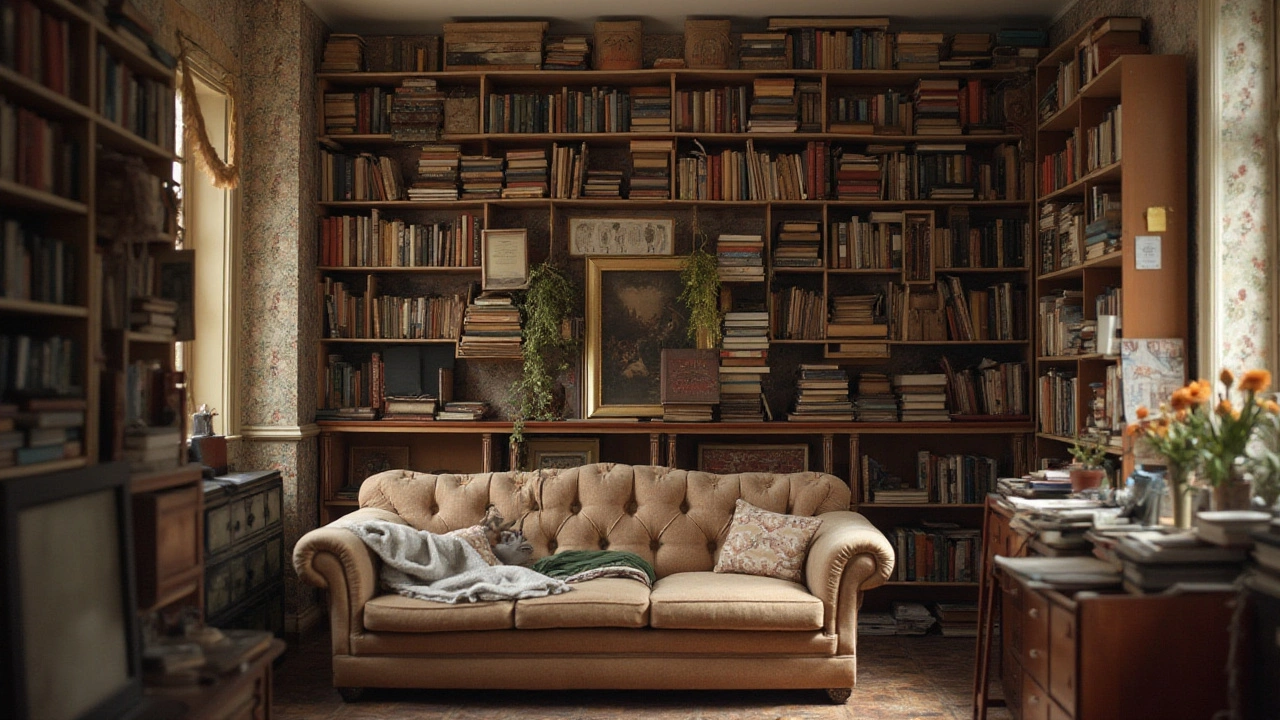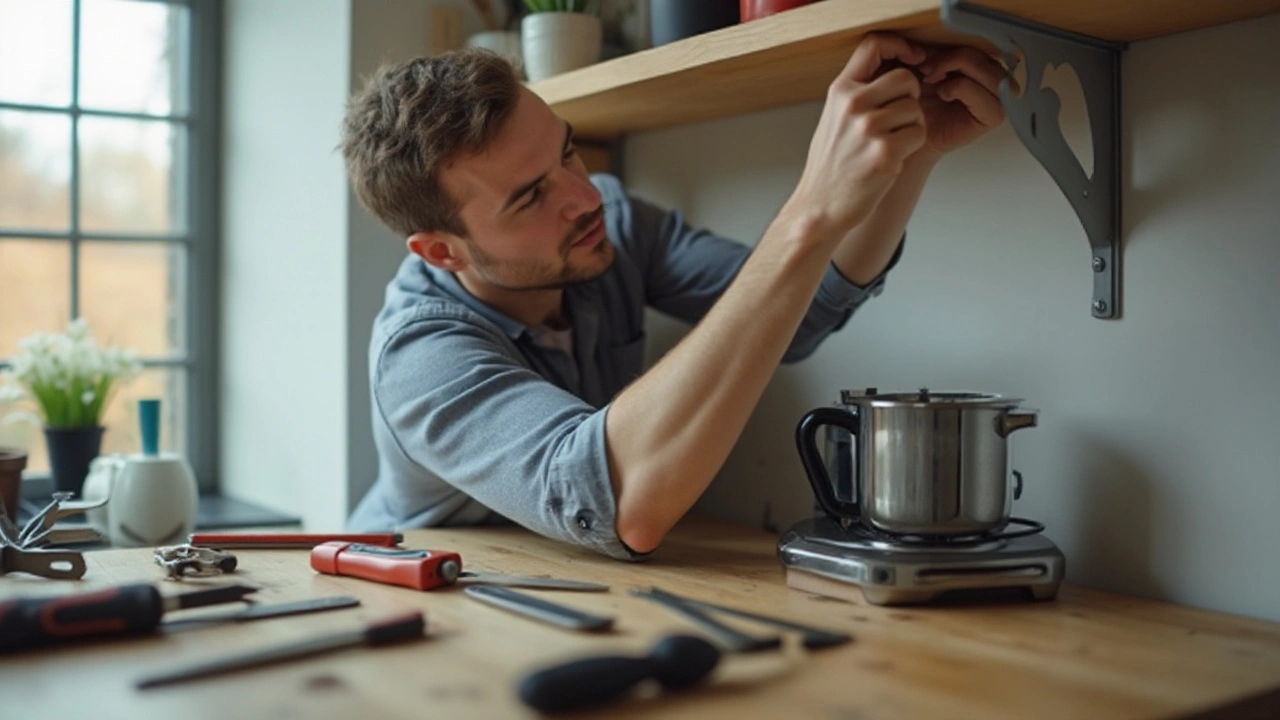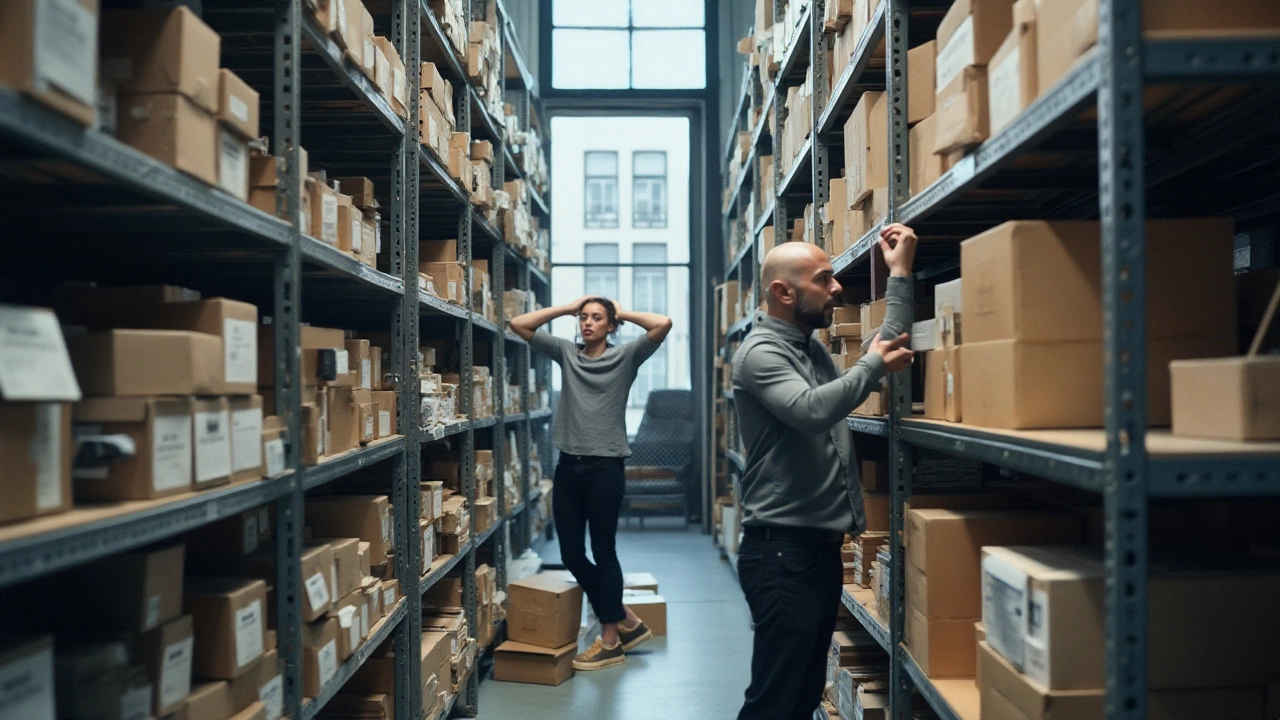Disadvantages of Shelving and Storage Solutions
 Jul, 22 2024
Jul, 22 2024
Shelving can seem like the ultimate solution to clutter, offering a structured way to organize and display items neatly. Many swear by it for transforming chaotic spaces into orderly retreats. But, shelving isn't always a perfect answer, and acknowledging the disadvantages is key.
While shelves help save floor space, they can also impose limitations due to their fixed dimensions. Customizing or expanding them can be a challenge without considerable cost or time investment. For those on a budget, shelves aren't always kind to the wallet, especially when considering high-quality or custom designs.
Then there are the safety concerns. Ensuring a shelf is securely fixed is essential to prevent accidents. Add maintenance to that, as shelves require regular cleaning and may even demand repair or replacement over time. With these concerns in mind, it’s vital to consider if shelving truly meets one’s storage needs or if alternative solutions might serve better.
- Space Limitations and Constraints
- Cost and Investment Concerns
- Stability and Safety Issues
- Maintenance and Durability Challenges
- Functional Limitations and Alternatives
Space Limitations and Constraints
Shelving, as we know it, has long been heralded as a game changer in the world of storage solutions. Yet it's not without its own set of constraints. While it promises to help organize and declutter, the reality is that shelves come with inherent shelving disadvantages tied to space. Physical dimensions of rooms can often oppose the dimensions of pre-made structures, causing an awkward fit. The space constraints of standardized shelving mean that customization options are limited, and this could potentially hinder maximizing the space you have.
When you think about fitting shelves into tight corners or oddly shaped walls, you'll encounter problems sooner than later. In small apartments or older homes where walls don't always run straight, these rigid structures might not slot in as neatly as expected. Then add the issue of depth—what fits comfortably for one room might impede passage in another, where every inch matters. A seemingly simple task of targeting storage issues might just unfold a pandora's box of hidden hurdles.
Fixed Dimensions and Flexibility
Underneath the aesthetic allure of shelving lies a fixed nature that can be quite restrictive. Pre-built shelves simply aren't adjustable, which means that if your needs evolve or if certain items don't fit as planned, you're left in a bit of a lurch. Growing kids, additional hobbies, or simply changing fashion tastes could soon outgrow your once-perfect shelving setup. This inflexibility can be particularly troublesome in urban settings, where every millimeter counts.
One notable source, the architectural expert Michael Abelson, once remarked,
"Our spaces should be designed to grow with us and not limit our possibilities."His words ring true when you consider the need for adaptable storage solutions that shelving tips often suggest avoiding by integrating custom-built, modular options.
Now, moving on to modern iterations, sliding shelves or adjustable units do attempt to mitigate these problems, yet they're often pricier and harder to find. The push for more bespoke shelving has given rise to smaller manufacturers, but not everyone has the luxury to afford custom solutions that align perfectly with existing room layouts. So, while shelving holds an allure of sophistication and ease, it's these very shelving drawbacks that challenge their efficacy in restricted spaces where it matters most.
Sometimes the issue isn't just with dimensions; it's also about how shelving impacts visual space. A packed shelf can make a room feel cluttered and cramped, swirling against the very principle it was supposed to support. To tackle this challenge, consider periodic decluttering, which can ensure shelves remain as functional as they are stylish. The key is to strike a balance between practicality and visual aesthetics, which might mean purging more often than you're accustomed to.
Cost and Investment Concerns
When considering shelving as a storage solution, it's crucial to think about the variety of costs associated with it. At first glance, simple shelves may seem inexpensive, especially mass-produced options from large retailers. However, these can quickly add up, particularly if the need arises for multiple units. Shelving disadvantages like hidden costs can sneak up on you. The base price often doesn’t account for things like mounting hardware, or the additional tools required for installation.
Shelving tailored to bespoke specifications can represent a significant investment, with custom units commanding premium prices. There's a reason why custom storage solutions are in a league of their own: the materials are often high-end, the craftsmanship is precise, and the aesthetics are fine-tuned. However, these perks come with a steep price tag that may not align with every budget. A striking fact here: custom shelving can easily run between $200 to $1000 per linear foot, depending on materials and complexity.
Now, let's not forget about the ongoing upkeep costs. Maintenance costs might be a silent player now, but they will become apparent over the years. If a shelf is made of wood, consider the costs of treating or re-varnishing it. Metal shelves might need repainting or rust-proofing. Once a shelf starts to wear, there can be an urgency to replace or repair, adding sudden expenses. Shelving tips might suggest regular care, but even these can feel burdensome over time.
Even the contributing costs often overlooked should be considered, such as the expenses for any necessary decor modifications to accommodate or match the implemented shelves. There can be those aesthetic adjustments you didn’t initially plan for that inflate original budgeting. Paintwork or wallpaper damage repairs are also real possibilities and can become essential if shelving units are repositioned or removed. Shelving might require a more significant financial commitment than first appears, which can impact decision-making.
There is also a time investment to factor in. Whether installing yourself or hiring contractors, both consume their share of valuable time. While the costs in dollars hold weight, the investment of personal time needs acknowledgment too. Many find their weekends dedicated to assembling, aligning, and re-aligning shelves, leaving little time for relaxation or recreation.
In light of these considerations, potential buyers must weigh their options carefully. Shelving solutions can be alluring in their potential to maximize space, but the accompanying financial investment might detract from that initial appeal. Carefully assessing needs, possible changes in usage, and economic capacity can steer one to more pragmatic decisions. A wise approach might involve seeking discounted sales, opting for semi-permanent shelving, or exploring DIY possbilities for tailored styles and designs.

Stability and Safety Issues
The stability and safety of shelving units are crucial concerns, especially when fitting shelves in homes and offices. The feeling that your shelves are secure provides peace of mind, but this isn't always guaranteed. Unstable or poorly fixed shelves can pose serious risks, not only to the items they hold but to the people nearby. Often, shelves might look steady, but unseen factors like uneven weight distribution or a weak anchoring system can create hazards. From tipping hazards to shelves collapsing entirely, the structural integrity of a shelving unit should never be neglected.
Ensuring stability often involves proper installation techniques. For example, using wall studs is paramount when anchoring shelves, as drywall alone might not support heavy loads. Additionally, the type of fastening materials matters significantly. High-quality brackets and screws must be chosen with the load capacity in mind. Interesting to note, a study once suggested that a surprising number of household accidents are due to unsecured shelving, prompting many home safety guides to stress proper installation. It's essential to think about what items you plan to place on the shelves. Overloading can cause bowing and eventually lead to failure.
According to the Consumer Product Safety Commission, “Each year, thousands of injuries are caused by furniture tip-over incidents, including those involving shelving units.”
Another aspect to consider is the potential for accidents involving children or pets. Kids may see shelves as a climbing adventure, and if a unit isn't fastened securely, this could lead to dangerous situations. Using safety straps or wall anchors specifically designed to prevent tipping can greatly reduce such risks. When selecting a shelving unit, look for models with sturdy backboards that can counterbalance and support the entire structure, offering an extra layer of safety.
Moreover, the material of the shelves plays a role in their stability. Wooden and metal shelves differ significantly in terms of weight distribution and potential to wobble or tip. Metal shelves, while strong, may dent or warp under long-term stress. Wooden shelves might bow over time if not supported adequately across their width. It’s wise to periodically check your shelves for signs of stress like bending or creaking, which can be early indicators of issues. Adhering to load limits provided by the manufacturer can help extend the lifespan and ensure continued safety.
Proper Use and Maintenance
Preventive maintenance and care are key to shelf stability. Regularly checking the alignment of your shelves and tightening any loose screws can prevent potential failures. Shelves that are overloaded or unevenly loaded can cause unnecessary strain on support structures, amplifying risks over time. Implementing a weight distribution strategy, such as placing heavier items toward the center or bottom of the shelf and lighter ones on top, can help maintain balance and stability. Moreover, avoiding abrupt contact with shelving units, such as bumping into them or using them irregularly, protects the integrity and prevents load shifts.
It's worth noting that newer shelving designs often incorporate safety features such as lock-in-place mechanisms or adjustable components that allow for flexibility without sacrificing security. As innovations continue to enhance these systems, shelving units become not only more secure but adaptable to a range of environments. Ultimately, understanding the specifics of stability and safety can transform shelving from basic storage solutions into trusted household features that enhance safety and functionality.
Maintenance and Durability Challenges
Shelving, seemingly a simple and permanent solution, often requires a surprising amount of upkeep to ensure it remains both functional and aesthetically pleasing. One possible issue is the need for regular cleaning and dusting, depending on the material. Wood shelves, beloved for their classic and warm appearance, require special attention as they are susceptible to scratches, stains, and moisture damage. Even metal shelving, which promises durability, can suffer from rust if not properly cared for. Each material comes with its unique set of upkeep demands, imposing regular tasks on the owner to maintain the shelves in pristine condition.
Add to this the inevitability of wear and tear. Over time, all types of shelves might sag or warp under pressure, particularly if overloaded or not installed correctly. This not only diminishes their storage effectiveness but also poses safety risks, as unstable shelves can topple or collapse. Keeping shelves in good shape might even involve occasional repairs or reinforcing structures to ensure they remain sturdy and safe. For DIY enthusiasts, this might translate to repairing brackets or investing in additional supports.
The demands don't end here. Another aspect that often goes overlooked is the cost of replacement parts or the actual shelf itself if it becomes damaged beyond repair. High-quality shelves that weather well and require less maintenance tend to come with a steep price tag initially. There lies a trade-off between investing in quality upfront and possibly encountering fewer issues down the line, versus opting for cheaper alternatives which might require frequent attention.
Renowned interior designer Sarah Richardson once said, "True beauty in our homes is found in its imperfections and the unique items we cherish." Indeed, while shelving may wear with time, its longevity can be enriched by focusing on its upkeep and personalization over the years.
Another hidden challenge is the agility of shelving systems to adapt to changing needs. A shelving system that works perfectly for today’s belongings might not serve for future collections or household changes. Thus, investing in modular or adjustable shelving might save headaches, as these can be reorganized or added to with ease. However, modular systems often demand their own unique maintenance considerations. Regular inspection for loose parts or connectors ensures the system remains reliable.
Not to be forgotten, even the diligent owner might face durability challenges from external forces. Seasonal changes can impact shelving, especially wooden units, through swelling or contraction. A common practice to combat this problem is careful placement away from direct sunlight or near heat sources.
The story of shelving is one where durability and maintenance go hand in hand. It’s not just about installing a shelf and walking away; it’s about engaging with the shelving as an evolving part of your living space. By doing so, you preserve its integrity, safety, and ability to complement your lifestyle in the way it was always intended.

Functional Limitations and Alternatives
Shelving systems bring a promise of tidiness and order, but they don't always live up to the hype. Many individuals discover that these systems have inherent functional limitations that are not immediately apparent. First, the issue of fixed structures: shelves are often immovable once installed, meaning any changes in room layout or function might require significant adjustments. This rigidity can be a dampener for those who enjoy rearranging or need to accommodate varying storage needs over time. The size and depth of shelves are other limiting factors. Deep shelves might bury items at the back, making them hard to reach and promoting clutter rather than organization.
"Shelves need to evolve with your life," says Jane Thompson, a noted space design expert. "Being stuck with a non-flexible solution can lead to more stress than convenience."
Moreover, shelving systems often fail to maximize storage potential in homes. Wall niches or corners remain underutilized, and this is where tailored solutions become essential. Adjustable shelving offers some flexibility, but not all types of shelving provide this benefit, particularly those designed with aesthetics in mind rather than utility. Dust accumulation is another functional issue, especially for open shelving. Items stored on them get dusty much faster, compelling homeowners to spend additional time on cleaning and maintenance. Beyond cleaning, reaching for things stored high up poses its own challenges, requiring tools that take up even more space.
So, what are the alternatives? Built-in cabinets can provide a more streamlined solution, offering concealed storage that complements the design of a room while utilizing available space effectively. Stackable storage units also offer a degree of flexibility, allowing for reconfiguration as required. Multidimensional setups can also be beneficial. Think about incorporating sliding panels or hidden compartments, which offer the versatility that standard shelving often lacks.
Repurposing furniture adds another layer of creativity to addressing the limitations of shelving. Consider using benches with built-in storage or tables that double as bookcases. It's about thinking outside the box, using what you have in new ways that complement lifestyle shifts. Finally, a move toward digital storage for books, movies, and music can drastically reduce the need for physical shelving, freeing up even more space and reducing household clutter.
A mix of innovative thinking and practical design can greatly alleviate the shortcomings of traditional shelving systems. Keeping up with changes in technology, lifestyle needs, and preferences is crucial to finding the most effective storage solutions, ones that will evolve alongside you and your living environment.